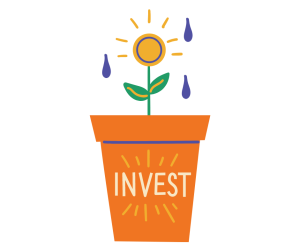Life Stage Investing

Life Stage Investment Objectives
Personal investing is a journey that mirrors the progression of our lives. From the exuberance of our youth to the wisdom that comes as we get older, each stage brings about different aspirations, evolving responsibilities, and changing financial needs.
In this article, we explore investing through the lens of different life stages, how our personal growth intertwines with financial planning with prioritise shifting from having enough money to live on, saving for the future and living out our retirement years.

Starting Out in the Workforce
When you are young, in your 20s and 30s, you are in what's known as the accumulation phase of life. During this time, it's essential to focus on building a strong financial foundation to pursue your long-term goals.
Investment-wise, this period is about wealth accumulation, and if your risk tolerance allows, you might consider higher-risk investments. Why? Because time is on your side. In investment terms, you have a long investment horizon. With many years ahead to earn and save, you can weather the ups and downs of financial market volatility.
However, as you age, your priorities shift. You may fall in love, get married, buy a house, and start a family. Consequently, it becomes prudent to gradually shift your investments away from higher-risk options. With a family dependent on you and less time available to recover from losses or endure market volatility, you may want to consider a more conservative approach.

Maturing and Preparing for the Future
A person in their 40s and 50s can be said to be in their pre-retirement phase, signalling the need to prioritise retirement planning. During this life stage, the investment objective should shift from “growth” to “income”, which means moving some money into safer, income-generating assets whilst reducing overall risk in your portfolio.
Assets that you may consider include high-quality bonds, dividend-paying stocks, and Real Estate Investment Trusts (REITs). Unlike when you were younger, when your portfolio may lean more towards stocks with growth potential, you should consider rebalancing to a more conservative allocation. This might entail adjusting your portfolio to approximately 50% equities, 35% bonds, and 15% cash.
If you are considering stocks in your portfolio, you may want to consider equities with moderate risk, such as dividend-paying blue-chip stocks and medium-capitalisation companies in relatively stable sectors like food, utilities, and healthcare.

Entering Your Silver Years
Once you reach your 60s onwards, you enter the retirement phase of your life, ideally reaping the rewards of your hard work over the past 40-odd years.
You may no longer have an active income-generating job, your accumulated retirement nest egg serves the purpose of generating the required income for you.
At this stage, the investment objective should shift to “security”, focusing on keeping your savings secure. You don’t want to take too much risk with your capital, so your money should be invested in very safe instruments that may offer only modest returns but come with very little or no risk.
This stage is sometimes referred to as the start of the "decumulation phase" of your life, when you begin to draw down on the assets you have accumulated. One way to manage your portfolio is to separate investments into two different buckets.
The first bucket will comprise a few years of income in zero- or near-zero risk savings to be used for immediate needs. This could include fixed deposits, Government-issued T-bills, or Singapore Savings Bonds.
The second bucket will have a higher proportion of fixed-income instruments that provide regular interest payments and mature in about 10 years or less.
Don’t forget that you also have your CPF accounts. You can incorporate optimizing your CPF into your overall planning. You can consider making top-ups to your CPF Special Account to earn higher interest and exploring options to monetize your property to have more resources in retirement.

The Irony of Investing
Before proceeding, a few words of caution are necessary.
Younger people typically have less money to invest due to their modest incomes and tendency to spend on fashion, lifestyle, and the latest gadgets. Despite having ample time to let their investments grow, they may not always prioritise investing.
On the other hand, older individuals often have more disposable funds. Many may have insurance policies that matured after 20-30 years, and they can also withdraw CPF funds at age 55, provided they have set aside the Full Retirement Sum in their Retirement Account.
However, with a significant sum of money becoming available, there is a strong temptation to rapidly “grow” this money for quick return. For those who may be tempted on this course of action, history serves as a reminder of the risks involved. For instance, in the 1990s, many retirees lost their nest eggs when Malaysian shares, traded on the speculative segment of the local market known as CLOB International, crashed in 1998 during the Asian financial crisis. (Reference: “Crypto is starting to be like another Clob saga”, The Strait Times, published on 2 January 2023. https://www.straitstimes.com/business/invest/crypto-is-starting-to-be-like-another-clob-saga.)
This is the irony of investing – younger people are able take on more risk, but they don’t, whilst older people can’t afford to take on too much risk but they do.
Make sure you don’t fall into this trap.

Establish the Fundamentals BEFORE Investing
Ensure you have built up a strong financial foundation with adequate insurance and emergency savings before delving into investing.
Here are some rules of thumb to consider (we refer to MoneySense Basic Financial Planning Guides. You can check out their guides here: https://www.moneysense.gov.sg/planning-your-finances-well/):
1. Emergency Savings. Strive to have at least 3 to 6 months’ worth of expenses saved up.
2. Protection with Insurance. Have adequate insurance protection for approximately 9 times your annual income for death and total permanent disability.
3. Protection for Health. For insurance protection again critical illnesses, it is recommended to have about 4 times your annual income as insurance cover.
4. Investing. Once you have prioritised for your emergency and protection needs, you can begin to plan and allocate at least 10% of your take-home pay (this is your income, after deducting CPF contributions) for investments.
Remember, an important fundamental principle of investing is to understand the investment product before you invest your money.
You can visit MoneySense for “An Introduction to Types of Investments” (link: https://www.moneysense.gov.sg/investments/types-of-investments/)
You can also read our article on “Get the Basics Right in Investing” (link: https://ccs.org.sg/articles/ccs-230113/).
| If you enjoy our articles, please follow and like our Facebook page. We post new content every week that you may find useful and engaging. |
Contributed by Credit Counselling Singapore
Published 15 March 2024.
